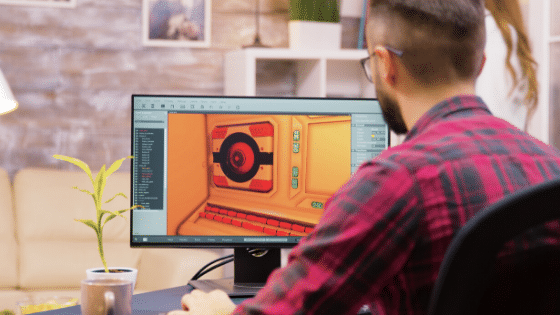2D Animation in terms of “Traditional Animation” is more complicated than 3d animation as there are about 24 drawings per second, or also referred to as frame by frame. This requires the animator to have had years of studying anatomy, physics, animation principles, and drawing skills to translate through the pencil. In current 2d and 3d animation, there are equal amounts of work that go into creating both modern-day practices of animation. Albeit different skills to create the artwork, the pipelines are relatively similar.
Keep reading, for, in today’s blog, we will break down 2D and 3D animation.
Difference Between 2D and 3D Animation
The primary difference between 2D and 3D animation is those 2D animators animate by drawing, as opposed to 3D animators who animate virtual puppets. The production processes are different, but in essence, they’re also the same. One uses computer software, where the other uses a person to draw each frame. They are both very specific on their methods, and animators understand that neither can be dismissed as “easy.”
Traditional 2D animation is simple by design but very time-consuming, but 3D animation can be smooth or quite complicated as well. For instance, if you want to animate a 3D ball bouncing in a simple scene, you can set up the ball and ground plane’s physics and dynamic attributes in a few short steps.
Other differences between 2D and 3D animation include the following. 2d animators use a physical animation disc backlit by a light source and a peg bar to hold paper whereas a 3d animator uses any computer strong enough to carry animation programs. 2d animators manually flip through drawings to get a sense of timing and movement, whereas a 3d animator scrubs a virtual “timeline” to see how the computer solves the interpolated calculations. (“Interpolation” is a fancy word meaning the computer figures out all the details between frames.)
2D Animation
- The 2D animation implies that the object is two dimensional
- Comprises of characters or objects only in height and width
- Created by a traditional drawing method. Every move of the character has to be created frame-by-frame with hand-drawing–called cell-animation. Today’s 2D animators, however, use the software on developing action sequences. Still, creating the first action scene has to be created, with the tool generating the rest of the motion sequences automatically.
- The CPU (or central processing unit) of a computer then does all the complex calculations to simulate forces, such as gravity, drag coefficients, wind/air resistance, etc., to simulate the ball falling. Then when the ball hits a “floor plane,” the calculations figure out the impact, surface area, and depleted energy for the ball to return into the virtual “air.” This cycle continues until the energy is depleted or infinitely based on how the animator chooses. The commodity of these skilled artists has driven up the market in recent years so the skilled 2d animators will cost more. The factor comes down to time spent, and traditional 2d takes more time than 3d animation.
- Modern 2d animation is less expensive
- Progresses at a steady pace
- All about frames
- Not appropriate for conceptual drawing as you can only be depicted in two dimensions.
- Widely animated in films, cartoon shows, websites, advertisements, e-learning courses, and engineering, etc.
- 2D animation was used for The Jungle Book, Snow White, and is currently used for The Simpsons and most animated series on Netflix.
- In 2D, you have to animate the shade and light of the character separately, as opposed to 3D animation, which is calculated by the dynamic lighting system. A one and done effort, which is also reusable.
3D Animation
- Characters are more “volumetric”, as you can have realistic 2D characters via Tarzan, Snow White, etc.
- Everything is done with computer software, with the development done in several phases or steps, including modeling, texturing, lighting, rigging, and rendering.
- More expensive due to needing a skilled professional to go through the animation course, which involves several steps for the expected outcome.
- The used computer programs figure out the majority of physics associated with movement and dynamic simulations.
- The cost of 3D has come down since its innovation. Now you will find 3D animation regularly in movies, gaming, medical, biotechnology, and aerospace.
- Examples include Toy Story, Transformers, and The Incredibles. Another benefit you get with 3d is a more pliable digital film camera that allows you to shoot your 3d subjects from all angles, whereas in 2d animation, you have to draw them from all the angles you want to film.
Regarding 2D animation, the level of difficulty also depends on your skill level. If you can draw quickly and efficiently (getting the form right immediately), it will probably be easier for you. 3D animation is quicker because you don’t need to animate every frame as you do with 2D animation. The software takes care of the frames-in-between, called “tweening.”
Difficulty of 2D
Here are some points to consider with 2D animation and its challenges. One is that with 2d animation, it needs a repeated and arduous effort of drawing the character from different angles.
In 2D animation, it’s almost impossible to animate with a rotating perspective and keeping the proper volumes and perspectives correct on the objects within the scene. Another tricky element of 2d animation is that the character in the scene must match the perspective of the background, usually created by another artist. If the character being animated doesn’t match the background, the character appears to be floating and not connected in reality.
In 3d animation, the background is usually imported into the primary animated character’s file via a process called “referencing.” This guarantees the animated character and the virtual world they reside in are cohesive.
At REVITY, our animators have years of experience and can transform your website to the next level of animation via advanced technology. Contact us to learn how.







